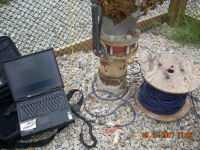Mining Topic: Methane Drainage and Migration
What is the health and safety problem?
Methane is an odorless, tasteless, colorless, inflammable, lighter-than-air gas formed by the decomposition of organic and other carbonaceous materials. Methane's low density (approximately 50% of the density of air) causes it to concentrate in the higher parts of underground mine environments. If ventilation is insufficient to properly mix the air with the mine air, methane levels between 5% and 15% can form an explosive mixture which, if ignited, can have catastrophic consequences. In this range, methane can be ignited easily, resulting in a violent explosion that may result in further explosions in the presence of combustible coal dust.
Drainage of methane from coal seams and from overlying formations is an effective technique to alleviate methane emission problems in coal mines. However, in order for methane drainage to be successful and produce the expected results, methane drainage systems must be designed according to specific geologic conditions, such as gassiness of the coal seam and overlying strata, specific gas emissions of the mine, and coal seam thickness and continuity.
What is the extent of the problem?
Gas drainage practices should be designed based on mine-specific conditions and needs using engineering control approaches. Currently, most gas drainage applications in individual underground coal mines are based on trial and error and by copying the practices used by other mines located in the same coal basin.
How is the NIOSH Mining program addressing this problem?

Measuring methane drainage at a borehole.
The former United States Bureau of Mines was very active in development of gas drainage boreholes for over two decades, mostly through field tests and observations in coal mines. The publication Methane Control for Underground Coal Mines is a significant source of material on this earliest work.
Building on this work, the Office of Mine Safety and Health Research (OMSHR) is addressing methane drainage and control problems by developing technologies to identify potential migration pathways and controlling them through methane drainage research. These research studies include field experiments, numerical simulations, and intelligent and statistical modeling approaches with consideration to site-specific details. These technologies help to detect and reduce methane gas levels. Challenges are being further addressed through the development of practical Methane Control and Prediction software to assist in methane emission prediction and drainage modeling.
What are the significant findings?
Findings of OMSHR's research on methane emission and degasification show that methane emissions from a mined coal seam and overlying strata can be significantly decreased by using in-seam and gob gas venthole drainage techniques. However, emission predictions and degasification design decisions must be based on operational and mine-design data, geologic and structural properties of the mining environment, and the size and in-place gas content of the gas emission zone.
What are the next steps?
The depth and breadth of research studies find their best value when they are validated and accepted by the industry. The use of developed techniques and recommendations, including validation and acceptance of OMSHR's Methane Control and Prediction software, are important milestones.
See the NIOSH Mining Products page for software, guides, training materials or other items related to this topic.
See Also
- A CART Technique to Adjust Production from Longwall Coal Operations under Ventilation Constraints
- Composition Change Model for Sealed Atmosphere in Coal Mines
- Degasification System Selection for U.S. Longwall Mines Using an Expert Classification System
- Development and Application of Reservoir Models and Artificial Neural Networks for Optimizing Ventilation Air Requirements in Development Mining of Coal Seams
- Forecasting Gob Gas Venthole Production Performances Using Intelligent Computing Methods for Optimum Methane Control in Longwall Coal Mines
- Guidelines for the Prediction and Control of Methane Emissions on Longwalls
- Methane Control by Isolation of a Major Coal Panel - Pittsburgh Coalbed
- Methane Control for Underground Coal Mines
- Methane Emission from U.S. Coal Mines, A Survey
- Methane Emission Rate Studies in a Northern West Virginia Mine
- Methane Emissions from Four Working Places in the Beckley Mine, Raleigh County, W. Va.
- Modeling and Prediction of Ventilation Methane Emissions of U.S. Longwall Mines Using Supervised Artificial Neural Networks
- A Numerical Evaluation on the Effects of Impermeable Faults on Degasification Efficiency and Methane Emissions During Underground Coal Mining
- Removing Methane (Degasification) from the Pittsburgh Coalbed in Northern West Virginia
- Reservoir Rock Properties of Coal Measure Strata of the Lower Monongahela Group, Greene County (Southwestern Pennsylvania), from Methane Control and Production Perspectives
- Rotary Drilling Techniques Used in the Beckley Coalbed
- Three Coal Mine Gob Degasification Studies Using Surface Boreholes and a Bleeder System
- Page last reviewed: 2/10/2014
- Page last updated: 9/22/2015
- Content source: National Institute for Occupational Safety and Health, Mining Program


 ShareCompartir
ShareCompartir